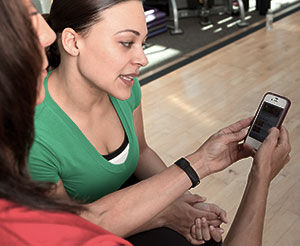
When new or potential clients walk into a fitness facility, they are typically handed a trifold pamphlet with charts mapping out various training plan options and their associated prices. How many times a week do you want to work with a trainer or coach? How many sessions are you willing to pay for in advance? Do you want to meet for 30 or 60 minutes at a time? And don’t forget, the first session costs twice as much as subsequent meetings.
Perhaps it’s time for personal trainers and health coaches to rethink these complex and antiquated pricing structures and instead “Spotify” their services for a flat, monthly fee. By partnering emerging technology with subscription plans, companies like Netflix and Spotify have been able to dominate the marketplace by delivering unending options with simple pricing structures. This article explores ways in which personal trainers, health coaches and other health and fitness professionals can develop a subscription-based business model that makes technology part of their everyday programming and client interaction. You can offer a monthly subscription for your services that allows you to become more of a full-service coach than someone who offers only fee-for-session programming. This non-traditional concept may seem a bit unusual at first, but consumers have grown accustomed to the monthly subscription model when paying for products and services, and trainers and coaches would undoubtedly thrive in this arena.
Driving Results Beyond the Facility Walls
A typical health coach or personal trainer’s income is inherently limited. Stated simply, if you currently meet with seven clients, five days a week, the only way to earn more money is by working overtime or raising your rates. Neither of these options constitutes a viable long-term career plan.
By earning money in ways other than face-to-face sessions, you can expand your client base considerably. Membership at your gym may not even be essential. If you are able to review a client’s diet and exercise remotely by tapping into the data provided by his or her wearable activity tracker, exchange emails with advice, education and encouragement, and offer programming that can take place anywhere, you may never even need to meet for a one-on-one session.
This is what Ted Vickey, M.A., an entrepreneurial strategist and a doctoral candidate in exercise adherence and technology at the National University of Ireland Galway, calls a “digital model of personal training.”
The thought of clients and facility members wearing activity trackers and beeping and buzzing their way through their workouts triggers a variety of responses among health and fitness professionals. Some anxiously envision a future of exercising cyborgs, in which personal trainers and health coaches have become nearly obsolete. Others may see these tech-savvy individuals as somewhat delusional in thinking that the latest gadget is all they need to get and stay on track.
What you should see is an opportunity.

There is no doubt that wearable devices from companies such as Fitbit, Jawbone and Garmin, which are often used in conjunction with smartphone apps and track everything from steps taken and caloric balance to sleep habits and exercise heart rate, have become ubiquitous. Consider the numbers: As of 2012, there were 30,500 health clubs in the United States boasting a total of 50.2 million members (International Health, Racquet and Sportsclub Association, 2013). Contrast that with the more than 130 million unique users of health-related smartphone apps owned by a single company—Under Armour, which owns MapMyFitness, MyFitnessPal and Endomondo (Adage.com, 2015). In other words, the digital health and fitness community using Under Armour–owned apps is more than 2.5 times the size of the entire U.S. fitness industry.
Clearly, health and fitness professionals would be wise to maximize the opportunities provided by this technology.
According to Inov8 Health CEO Tom Futch, who has more than 25 years of experience in the health and fitness industry, the role of professionals can be broken down into three elements: (1) creating a more engaging experience for the client, (2) allowing clients to learn how to form healthy habits and (3) driving successful outcomes for clients through the accomplishment of personal goals. If these three aspects of training are in place, Futch says, revenue will take care of itself. Importantly, all of these elements can be enhanced through the use of technology. A periodic review of a client’s fitness app data can improve communication and enhance your training by allowing you to positively impact client behavior outside the gym.
Vickey explains that it is possible to build a business that integrates training and coaching with emerging technology. “As a trainer,” says Vickey, “you may see a client two or three days each week. The technology creates accountability for what the client does the other four or five days.” Your role is to help the client use the data provided by the device and turn it into ongoing behavior change. If a client is not taking enough steps or exercising with enough intensity when outside the gym, for example, you can help the client incorporate more challenging, yet still enjoyable, activities to do on their own.

Social Networks = Social Support
You know all about the importance of social support to the long-term success of your clients, but are you using social media to optimize its impact? Both Ted Vickey and Tom Futch recommend gathering groups or teams of clients who use activity trackers and having them form a private group on Facebook or other social media. You can meet with the group at the outset to teach them how to best use their devices and have a dialogue about the importance of healthy living outside the gym. Both group and individual goals can be established, and you should encourage participants to cheer each other on by offering digital high fives and supportive messages. The value in this type of support cannot be overstated.
Some apps allow users to grant access to a trainer or coach—and this will likely become more common as the technology progresses. Others sound an alarm on your phone whenever a client hits one of his or her goals, such as burning a certain number of calories or taking a set number of steps each day. If you have the same device as a group of clients, the associated app may allow you to “friend” them and track their data on an ongoing basis. You can then reach out if you see a troubling pattern or, better yet, offer congratulations when clients are meeting or exceeding their goals.
This model works particularly well in corporate wellness environments, where the formation of teams and the development of social support is a natural extension of the programming.
Many clients make the mistake of thinking that three or four visits to the gym each week is enough to counteract their otherwise sedentary lifestyles. Consider this example provided by Tom Futch: During a weekly review of a client’s fitness app data, you find that, while she is meeting her goals on days she visits the gym, she is averaging only 2,500 steps per day when she does not have a training session with you. You can then work with her to develop a plan to increase that number to 5,000 steps a day for a few weeks before progressing further, with an eventual goal of reaching 10,000 daily steps. Without the wearable device and associated app, you would have to trust the word of the client regarding her activity level, and many people have a tough time accurately describing their daily routines. The hard numbers provided by the device remove that burden from the client and motivate many people. In this scenario, according to Futch, you have found a way to “deliver value to the client and drive results outside the gym.”
Vickey notes that health and fitness professionals can also use the data collected by these devices and apps to look for patterns that are impacting a client’s successes or struggles. Perhaps Sundays during football season trigger excessive eating. Maybe your client struggles to get adequate physical activity when traveling for business. Or maybe your client finds it difficult to stay on track during the summer months when his or her kids are home from school. By identifying patterns and obstacles and helping clients find ways to maintain consistency, you are helping them achieve a more active lifestyle.
In Conclusion
Vickey describes health and fitness apps as being like a diagnostic for the body, similar to what an auto mechanic uses to determine what’s wrong with a car. Through the use of wearable devices, you now have access to reliable information that wasn’t available just a few years ago. Resting heart rate, exercise heart rate, sleep quality and duration, steps taken, nutritional breakdowns of food intake, distance traveled during outdoor exercise—all of this is available at the touch of a button. That said, data alone does not create improvements in health and well-being, and that is where you come in. Training, coaching and group instruction are still very much needed, and clients will likely seek your help turning data into action.
In the modern, hyper-connected, tech-driven world, many clients may not be satisfied with the traditional two-workouts-a-week training routine, and instead want ongoing support and a more holistic coaching model. Professionals who embrace technology are best positioned to fill that role.
References
Adage.com (2015). Under Armour Adds Two Fitness Apps in Fight Against Nike. http://adage.com/article/digital/armour-acquires-fitness-apps-myfitnesspal-endomondo/296990/
International Health, Racquet and Sportsclub Association (2013). About the Industry. www.ihrsa.org/about-the-industry/





 by
by 




